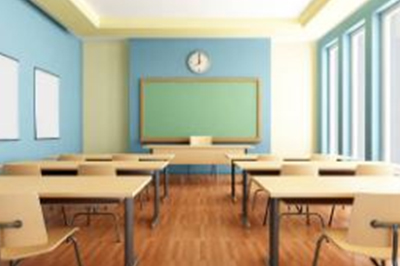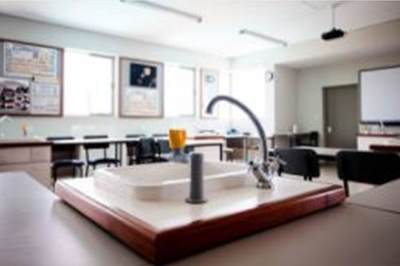Interior Design Extra Features
Interior Extra Features
Design for Common Area
The design for the common area is appropriate for the age group served.
From the supporting literature (linked),
1. The design pattern including large group spaces influence learning.
2. Providing enough space for social density should be emphasized.
3. Providing indoor common area is necessary for decrease discomfort provided by interpersonal closeness.
Furniture Design (FD)
The furniture used and designed in study rooms have an appropriate size, color, and material for students.
From the supporting literature (linked),
1. There is a relationship between school facility design (equipment and furniture as an example) and students’ achievements.
2. Furniture design as one example of architectural design of school buildings influence the crime rate.
3. The importance of the placement and size of classrooms doors and windows is discussed.
Identifying Path for Safe Rooms (IDS)
Clear routs for safe areas are visible upon existing classroom.
Interior Design and Student Performance
The influence of school buildings interior design on student performance and behavior.
From the supporting literature (linked above),
1. The aspect of interior design influences students’ behavior, attitudes, achievement, their self definition, and identity.
2. Six interior design elements including color, choice, connection, complexity, flexibility, and light were associated with student learning rates.
3. Four interior design elements including ownership, flexibility, complexity, and color were responsible for individual student outcomes.
4. Students learning and achievements are influenced by classroom symbolic features and spatial density. E.g; wall decor and objects.
Design for Technology
The technologies and systems used in classrooms are designed and maintained well.
From the supporting literature (linked), there is a need to use different forms of technologies within learning spaces to create new possibilities.
Floor Materials (FM)
The materials used for flooring are appropriate for the age of students and subject taught.
Hallway
The hallways are designed wide enough to decrease overcrowding.
Sink
classrooms are equipped with an accessible sink.
Student Movement Monitoring (SMM)
School interior design should be able to control students movement, behavior, and safety.
From the supporting literature (linked), schools should be designed in a way to control students movement, behavior, and safety. Flexible classrooms, progressing technologies, and sustainable interior materials should be provided.
References
1. Barrett, P., Zhang, Y., Moffat, J., & Kobbacy, K. (2013). A holistic, multi-level analysis identifying the impact of classroom design on pupils’ learning. Building and Environment, 59, 678-689.
2. Barrett, P., Davies, F., Zhang, Y., & Barrett, L. (2015). The impact of classroom design on pupils’ learning: Final results of a holistic, multi-level analysis. Building and Environment, 89, 118-133.
3. Biddle, B. J., & Berliner, D. C. (2008). Small class size and its effects. Schools and society: A sociological approach to education, 3, 86-95.
4. Blackmore, J., Bateman, D., Loughlin, J., O’Mara, J., & Aranda, G. (2011). Research into the connection between built learning spaces and student outcomes.
5. Cheryan, S., Ziegler, S. A., Plaut, V. C., & Meltzoff, A. N. (2014). Designing classrooms to maximize student achievement. Policy Insights from the Behavioral and Brain Sciences, 1(1), 4-12.
6. Earthman, G. (1996). Review of Research on the Relationship between School Buildings, Student Achievement, and Student Behavior.
7. Earthman, G. I., & Lemasters, L. K. (1997). Can Research Findings Help School Systems Obtain the Most Bang from the Construction Bucks?.
8. Earthman, G. I. (2004). Prioritization of 31 criteria for school building adequacy. Baltimore, MD: American Civil Liberties Union Foundation of Maryland.
9. Earthman, G. I., & Lemasters, L. K. (1997). Can Research Findings Help School Systems Obtain the Most Bang from the Construction Bucks?.
10. Filardo, M. (2016). State of Our Schools: America’s K–12 Facilities 2016. Washington, DC: 21st Century School Fund.
11. Fisher, K. (2001). Building Better Outcomes: The Impact of School Infrastructure on Student Outcomes and Behaviour. Schooling Issues Digest.
12. Fuller, B., Dauter, L., Hosek, A., Kirschenbaum, G., McKoy, D., Rigby, J., & Vincent, J. M. (2009). Building schools, rethinking quality? Early lessons from Los Angeles. Journal of Educational Administration, 47(3), 336-349.
13. Guo, Y., Piasta, S. B., Justice, L. M., & Kaderavek, J. N. (2010). Relations among preschool teachers’ self-efficacy, classroom quality, and children’s language and literacy gains. Teaching and Teacher Education, 26(4), 1094-1103.
14. Hughes, S. M. (2005). The relationship between school design variables and student achievement in a large urban Texas school district (Doctoral dissertation).
15. Katyal, N. K. (2002). Architecture as crime control. The Yale Law Journal, 111(5), 1039-1139.
16. Lumpkin, R. B., Goodwin Jr, R. T., Hope, W. C., & Lutfi, G. (2014). Code compliant school buildings boost student achievement. SAGE Open, 4(4), 2158244014556993.
17. Schneider, M. (2002). Do School Facilities Affect Academic Outcomes?.
18. Smith, T. M., Rogers, G. T., Alsalam, B., Perle, M., Mahoney, R., & Martin, V. (1994). The condition of education. Department of Education.
19. Strickland, A., & Hadjiyanni, T. (2013). “My School and Me”—Exploring the Intersections of Insideness and Interior Environments. Journal of Interior Design, 38(4), 17-35.
20. Tanner, C. K. (2008). Explaining relationships among student outcomes and the school’s physical environment. Journal of Advanced Academics, 19(3), 444-471.
21. Tanner, C. K. (2009). Effects of school design on student outcomes. Journal of Educational Administration, 47(3), 381-399.
22. Weinstein, C. S. (1979). The physical environment of the school: A review of the research. Review of educational Research, 49(4), 577-610.
23. Yarbrough, K. A. (2001). The Relationship of School Design to Academic Achievement of Elementary School Children.












